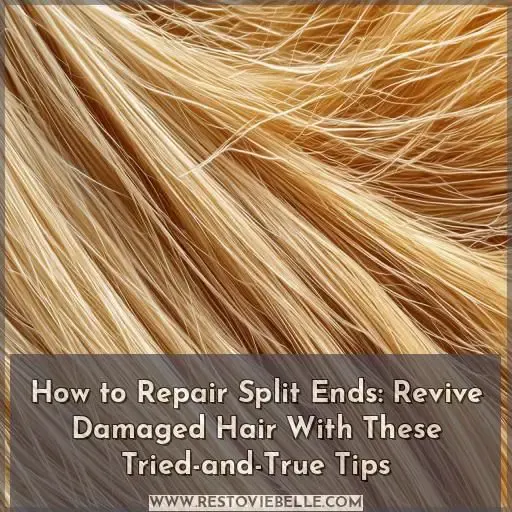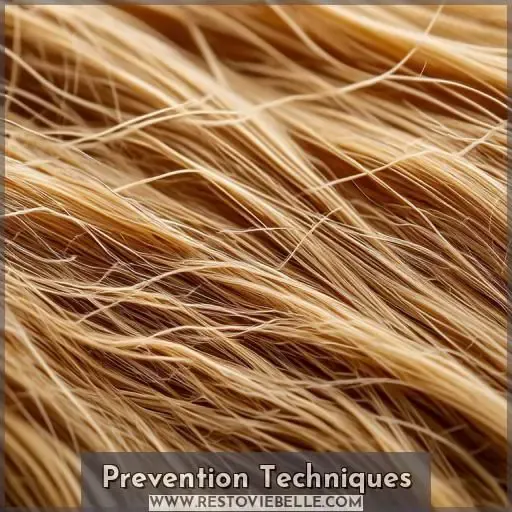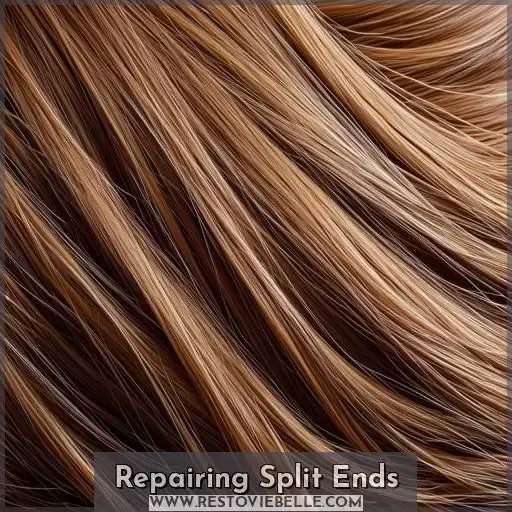This site is supported by our readers. We may earn a commission, at no cost to you, if you purchase through links.
 To repair split ends effectively, start by trimming your hair every 6-8 weeks using high-quality shears.
To repair split ends effectively, start by trimming your hair every 6-8 weeks using high-quality shears.
Limit heat styling by air drying or using heatless curls. Embrace gentle hair care with a wide-tooth comb and nourishing hair masks like coconut or argan oil.
Protective hairstyles and sleeping on silk can minimize friction and breakage. Almond oil or coconut oil can conceal split ends, and leave-in conditioners help seal and soften them.
Maintain healthy habits like scalp massages and staying hydrated. Stick to these tips, and you’ll protect and revive your hair, gradually reducing split ends.
Want more details? We have you covered.
Table Of Contents
Key Takeaways
- Snip, snip! Regular trims are your secret weapon against split ends.
- Heat styling? Not so fast! Give your hair a break and let it air dry or embrace heatless curls.
- Treat your hair like a princess! Use gentle hair care, and don’t forget to nourish it with masks and leave-in conditioners.
- Protect your precious locks! Sleep on silk, wear protective hairstyles, and avoid over-brushing to keep split ends at bay.
How to Repair Split Ends?
To repair split ends, regularly trim your hair and use nourishing treatments like hair masks and leave-in conditioners (Source). These methods help remove damaged ends and keep your hair healthy and strong .
Causes of Split Ends
You’re likely familiar with the dreadful sight of split ends – those pesky, frayed strands that mar your hair’s smooth appearance. Split ends arise from chemical treatments like coloring and perms, heat styling tools, and rough handling that damages the hair cuticle.
Chemical Treatments
You’re likely familiar with the damaging effects of chemical treatments like:
- Hair dyes and bleach
- Chemical relaxers
- Perming solutions
These harsh chemicals roughen the hair’s cuticle, leading to breakage and split ends. Hair extensions can also put strain on strands, causing similar issues. To maintain hair health, minimize chemical processing and be gentle with treated locks.
Heat Styling
Excessive heat styling is another major culprit for split ends. Blow-drying, flat-ironing, and curling your hair exposes it to high temperatures that weaken the outer cuticle layer, leading to dryness, brittleness, and breakage. Always use a heat protectant product before thermal styling and limit the frequency of these damaging techniques.
Rough Handling
You’re also putting your hair at risk when you roughly brush or forcefully comb it. Wet hair is extra vulnerable, so be gentle when detangling. Tangled hair creates weak points that can snap, leading to:
- Frayed, split ends
- Uneven breakage
- Thinning, damaged strands
To minimize friction and breakage, try:
- A wide-tooth comb
- Detangling before brushing
- Sleeping on a silk pillowcase
- Wearing a satin scarf at night
Prevention Techniques
To prevent split ends, you’ll want to adopt gentle hair care practices like using a wide-tooth comb and blotting hair dry with a towel to minimize friction and breakage. Protective hairstyles that keep ends tucked away, as well as limiting heat styling, can also help mitigate damage and split ends.
Gentle Hair Care
To prevent split ends, you must treat your hair gently. Blot and detangle hair with a wide-tooth comb when wet to minimize breakage. Regularly use a nourishing hair mask to strengthen strands. Friction from towels and brushes can rough up the hair cuticle, so handle with care. Stay hydrated and massage your scalp to promote healthy hair growth.
Protective Hairstyles
You can protect your hair by 1) braiding it in loose styles, 2) wearing satin or silk scarves at night, and 3) using soft accessories like scrunchies. These techniques minimize friction and tangling, preventing split ends. For instance, braids keep your hair contained while scarves create a smooth surface, reducing breakage. Dry shampoo alternatives also help extend your style.
Limit Heat Styling
You’ll want to limit your use of heat-styling tools to prevent further damage. High temperatures can wreak havoc, causing split ends and breakage. Consider these heat-free alternatives:
| Air Dry | Heatless Curls | Braids |
|---|---|---|
| Let hair dry naturally | Rag or banding method | Protective styles |
| Embrace your texture | No heat required | Minimize friction |
Giving your strands a break from intense heat is a surefire way to revive their luster and strength.
Repairing Split Ends
Trimming your hair is the most effective way to eliminate split ends and prevent further damage. If you’re not ready for a trim, you can temporarily conceal split ends by applying coconut or almond oil, which smooths and seals the hair cuticle, or by styling your hair in updos that hide the frayed ends.
Trimming Hair
To keep your hair healthy, let’s explore the topic of trimming. Regular trims are essential to prevent split ends and promote growth. Here’s what you need:
- Trim frequency: Every 6-8 weeks.
- Best scissors: Invest in high-quality shears.
- Professional vs at-home trims: Choose what suits you best.
- Split end prevention after trims: Maintain with regular care.
Concealing Split Ends
When you notice split ends, concealing them can buy you time before your next trim. Use natural oils like coconut or almond oil to smooth frizzy ends. Try protective hairstyles such as buns or extensions for a polished look. Hair scarves add flair while hiding damaged ends. These simple fixes keep your hair looking chic and healthy.
| Concealing Split Ends | Home Remedies | Natural Oils |
|---|---|---|
| Protective Hairstyles | Hair Scarves | Coconut Oil |
| Buns | Extensions | Almond Oil |
| Polished Look | Frizzy Ends | Smooth |
Nourishing Treatments
Incorporate nourishing treatments like hair masks and leave-in conditioners to repair split ends and revive your hair. These products provide essential moisture and nutrients, helping strengthen and smooth damaged strands for a healthier look .
Hair Masks
Hair masks play a critical role in repairing split ends and preventing breakage. Utilizing homemade recipes with moisturizing ingredients like avocado or honey, these treatments provide deep conditioning. Nourishing oils, such as coconut and argan, work wonders by sealing the hair cuticles, ensuring your hair stays strong, shiny, and well-moisturized (Source).
Leave-in Conditioners
Leave-in conditioners, packed with nourishing ingredients, help seal split ends, providing a barrier against further damage. Apply them to damp hair to lock in moisture and protect strands. Use regularly, but moderate the frequency based on hair type. These conditioners soften your hair, making it easier to detangle and style without breakage .
Lifestyle Habits
To protect your hair and prevent split ends, try sleeping on a silk pillowcase, which reduces friction and potential damage . Additionally, avoid over-brushing to minimize stress on your hair cuticles and reduce breakage .
Sleeping on Silk
To protect your hair from split ends, try sleeping on a silk pillowcase. The smooth surface reduces friction, which helps prevent breakage and tangling. This nighttime protection promotes hair smoothness and overall health. Switching to a silk pillowcase is an easy step to incorporate into your hair care routine for long-term damage prevention .
Avoiding Over-Brushing
Avoid over-brushing to prevent hair breakage. Brush your hair less frequently to avoid damage. Use a gentle, wide-tooth comb and always detangle before brushing. Incorporate this into your hair care routine to maintain healthier hair. Gentle brushing reduces stress on your strands, minimizing the risk of split ends and ensuring your locks stay strong and vibrant.
Frequently Asked Questions (FAQs)
Does hair type affect susceptibility to split ends?
Don’t worry if you’ve got curly or fine hair; all types can experience split ends. However, finer hair is generally more prone to breakage due to its delicate structure and lower moisture retention.
Are there specific haircuts to prevent split ends?
Opt for regular trims every six to eight weeks to prevent split ends. Choosing haircuts like blunt cuts or layers, which reduce weak points and help maintain hair health, also minimizes the likelihood of split ends .
Can diet influence the health of hair ends?
Your diet has a considerable impact on hair ends. Nutrient deficiencies can weaken hair, making it prone to breakage and split ends . Eat a balanced diet with vitamins and minerals like biotin, zinc, and omega-3 fatty acids.
Is air drying hair better for split ends?
Yes, air drying is better for split ends. Avoiding heat treatments reduces further damage and breakage. Pat your hair dry with a towel, detangle gently, and let it air dry to promote healthier hair ends.
How do environmental factors impact split ends?
Environmental factors like UV radiation, pollution, and humidity can weaken hair, making it susceptible to split ends and breakage. These elements strip natural oils, dry out hair, and intensify damage over time (Source).
Conclusion
Over 50% of individuals experience split ends due to hair damage.
To repair split ends effectively, adopt a routine that includes regular trims, limited heat styling, and gentle hair care practices such as using a wide-tooth comb and nourishing hair masks.
Embrace protective hairstyles, and consider sleeping on silk to minimize friction.
Incorporate nourishing treatments like almond oil, coconut oil, and leave-in conditioners to conceal split ends.
Stay hydrated and perform scalp massages to revive and protect your hair.











